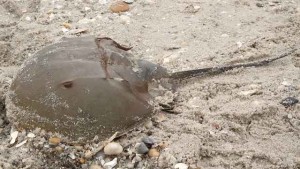
DELAWARE BAY, DELAWARE - The empty shells of an unfortunate horseshoe crab or two are a common sight on the popular Jersey shore (that’s what locals call the beach in these parts) during the early summer beach season. Occasionally a child may tentatively investigate one, but most steer clear of what’s left of the dangerous-looking arthropod.
What many people never see, and probably aren’t even aware of, is the frenzy going on in the nearby (and less frequented) Delaware Bay. Hundreds of thousands of the crabs come ashore there every year in May and June to mate and lay eggs, and then mostly disappear as the summer gets into full swing.
The horseshoe crab is a bit intimidating at first, looking like a cross between an amphibious assault vehicle and a creature out of the movie Alien. In reality, you’d need to go out of your way to get harmed by one – though Jim Hewes, the science teacher and volunteer crab surveyor whom we interviewed for this video, confided in us that he did once get stabbed through the boot by a crab’s spike-shaped tail, or telson, when he stepped on it by accident.
The crabs use their tails to try to turn themselves over if they get flipped upside down, though they aren’t always successful, as documented by the beautiful clock-face pattern in the sand that surrounds the crab that Jim rescues in the story. The telson is attached to the crab by tendons, which tend to get injured if the crab is picked up by it. So if you ever attempt to rescue a flipped horseshoe crab, the best way is to hold it by its shell.
Horseshoe crabs, as it turns out, aren’t really crabs at all but a separate subphylum, which makes them more closely related to things like scorpions and spiders. The males and females can be told apart by their size (females grow much larger) and their appendages. The male possesses specialized ones designed to latch onto the back of the female while mating. The Atlantic horseshoe crab (Limulus polyphemus) has its main migration in the Delaware Bay.